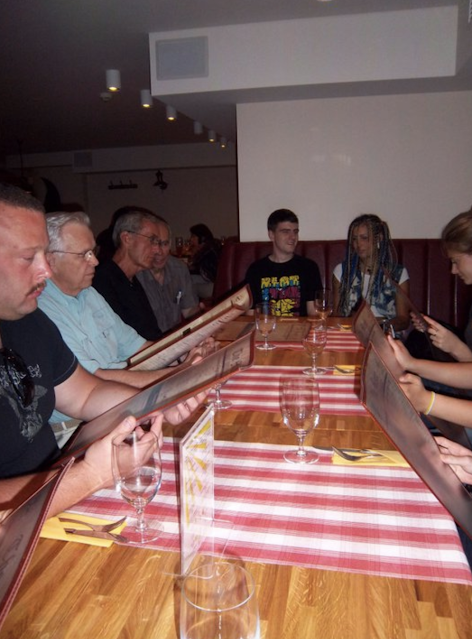On Monday, we set off to work. This is the building we were helping to renovate.
The ground floor has a large, two story high great room. On three sides, there is a balcony with doors into private rooms that will become bedrooms with bathrooms.
One project was in the basement where we had to cut through the concrete floor to replace and reconfigure a drain pipe.
There are some 50 windows, each with two rectangular pieces at the bottom and two quarter circle pieces at the top, on both interior and exterior windows - 8 pieces per window for a total of 200 to scrape, sand and paint.
There was a lot of patching and sanding of walls in the rooms upstairs.
Lunches were delivered each day and we would usually eat outside. On Monday, the NGO that will operate the center was there, and a TV crew interviewed them and us.
There was a whole campus of buildings, with chapels, schools and offices.
Each morning fter breakfast, we waited out in front of the hotel. Tuesday was no different.

The day was spent working on windows, working in the basement and patching, sanding and prepping to paint walls.
During a break, I explored the huge attic.
After work and showers, we toured a local brew pub and had a excellent dinner there.
On Wednesday, we stopped at Castorama - there are several European chain stores that are comparable to Lowes and Home Depot. Castorama became our favorite stop each morning to pool money and buy tools to donate to the local Habitat chapter. Our first purchase was a vacuum for cleaning the 15 years of dirt (the building had sat unused since 1995) - there was just a lot of dust and dirt to be cleaned up.
Late morning, we took a break and visited a chapel where a summer camp group was meeting. Adam, the local Habitat director, was an organist and we all enjoyed a short organ recital.
After lunch, it was back to windows, prepping walls/ceilings and working on deconstruction of old bathrooms.
After work, we visited the Gliwice Radio Tower:
The Gliwice Radio Tower—the tallest wooden structure in Europe (at 387 feet)—still stands, although the station has long ceased to exist. Its building now houses a museum dedicated to the incident. The massive wooden tower now carries aerials for mobile phone services and FM broadcasting. The site itself now belongs to Poland.
This tower is often referred to as the place where WWII began. Here is what Wikipedia says:
The Gleiwitz incident (German: Überfall auf den Sender Gleiwitz; Polish: Prowokacja gliwicka) was a false flag attack on the German radio station Sender Gleiwitz, staged by Nazi Germany on the night of 31 August 1939. Along with some two dozen similar incidents, the attack was manufactured by Germany as a casus belli to justify the invasion of Poland, which began the next morning.[1] The attackers posed as Polish nationals.
During his declaration of war, Hitler did not mention the Gleiwitz incident but grouped all provocations staged by the SS as an alleged "Polish assault" on Germany. The Gleiwitz incident is the best-known action of Operation Himmler, a series of special operations undertaken by the Schutzstaffel (SS) to serve German propaganda at the outbreak of war. The operation was intended to create the appearance of a Polish aggression against Germany in order to justify the invasion of Poland. Manufactured evidence for the Gleiwitz attack by the SS was provided by the German SS officer, Alfred Naujocks in 1945.[1]




















































No comments:
Post a Comment